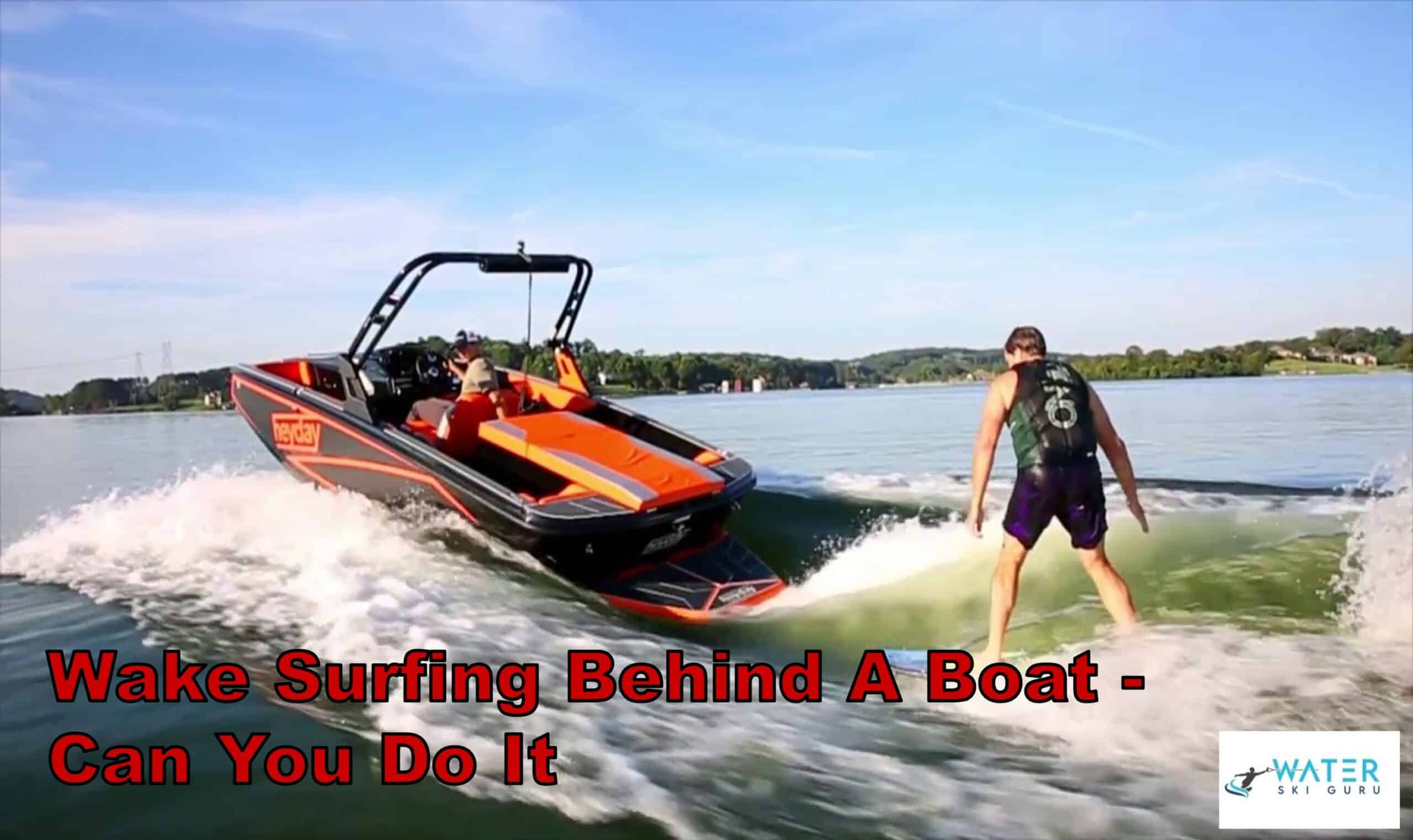As a seasoned wake surfer, I can attest to the thrill and excitement that this water sport brings. But for beginners, the idea of surfing behind a boat may seem daunting or even impossible.
The truth is, anyone can learn to wake surf with the right equipment, technique, and safety precautions.
In this article, I will guide you through the basics of wake surfing behind a boat. From understanding what wake surfing is to finding the right boat and speed, getting up on the wake, riding the wave without a rope, and staying safe while doing so.
So if you’re ready to take on this challenge and experience an adrenaline rush like no other, let’s get started!
What is Wake Surfing?
You might be curious about wake surfing, which involves riding the boat’s wake using a specially designed board while being towed behind the boat.
Wake surfing has a long history dating back to the 1960s when surfers in California experimented with towing behind boats. The modern version of wake surfing emerged in the early 2000s and it has grown in popularity ever since.
Wake surfing is considered an easy sport to learn, yet difficult to master. Beginners can start by sitting or kneeling on the board while holding onto a rope attached to the boat. Once comfortable, they can gradually stand up and ride the boat’s wake without holding onto any ropes. Advanced techniques include spins, jumps, and other tricks that require speed and precision.
One of the benefits of wake surfing is that it provides a low-impact full-body workout that improves balance, coordination, and core strength. Additionally, participating in competitions adds an element of excitement and challenge for those seeking mastery in this sport.
Whether you’re a beginner or an experienced surfer looking for a new challenge, wake surfing is definitely worth trying out!
The Equipment You Need to Get Started
Got some cash to burn? Want to show off your latest gadgets? Well, all you need is the right equipment and you’re ready to hit the waves like a pro! Wake surfing behind a boat is an exhilarating experience that requires skill and proper gear. Choosing the right board is crucial to ensure stability, speed, and maneuverability on the water.
When selecting a wake surfboard, there are several factors to consider such as the rider’s weight and skill level. A beginner should opt for a larger board with more surface area for better balance. On the other hand, experienced riders can choose smaller boards with less buoyancy for faster turns and advanced tricks. Additionally, it’s essential to find the proper stance by placing one foot forward while keeping knees slightly bent. This position allows riders to maintain balance on the wave.
Balancing on the wave may seem daunting at first but with practice comes perfection. Avoiding common mistakes such as leaning back or looking down can help keep balance and prevent falls. It’s also important to start slow and gradually increase speed once comfortable on the board. Progressing to advanced tricks like 360s or riding switch requires patience and dedication but ultimately adds excitement and challenge to wake surfing behind a boat. With these tips in mind, anyone can become a skilled wake surfer with the right equipment and practice.
| Board Size | Rider Weight | Skill Level | Buoyancy | Maneuverability |
| Large | Beginner | Novice | High | Low |
| Medium | Intermediate | Intermediate | Moderate | Moderate |
| Small | Advanced | Expert | Low | High |
Table: Wake Surfboard Guide
Finding the Right Boat and Speed
Once you’ve got the proper equipment, it’s important to find the right boat and speed for an optimal wake surfing experience. Boat selection is crucial because not all boats are suitable for wake surfing. You need a boat with a hull design that can produce a large enough wake without causing too much turbulence.
Speed control is essential when wake surfing because it determines the size and shape of the wave. The ideal speed range for most boats is between 10-14 mph, but this can vary depending on the boat and surfer’s preferences. It’s best to start at a slower speed and gradually increase until you find your sweet spot.
Weight distribution also plays a significant role in creating an ideal wake surfing wave. Distributing weight evenly across both sides of the boat will create a more symmetrical wave, making it easier to surf.
Lastly, selecting the right surfboard depends on personal preference and skill level. A longer board provides stability while shorter boards allow for more maneuverability.
By taking into account these factors, you can find the perfect combination of boat selection, speed control, weight distribution, and surfboard choice to achieve an optimal wake surfing experience. With practice and experimentation, you’ll soon find what works best for you and be able to master this exhilarating water sport.
Getting Up on the Wake
First things first, it’s all about finding your balance and positioning yourself properly on the board. Wake surfing requires a different set of skills compared to traditional water skiing or wakeboarding. It’s important to note that it takes time and practice to get the hang of it. Body positioning is key when getting up on the wake. A common mistake beginners make is standing too upright which can cause them to lose their balance and fall off the board.
To ensure proper body positioning, you should start by lying on your back with your feet facing towards the boat. Once you feel comfortable in this position, gently pull yourself up into a crouching position while keeping your arms straight and close to your body. This will help distribute your weight evenly across the board, making it easier for you to maintain balance as you ride.
As a beginner, there are several tips that can help improve your technique and prevent common mistakes. For instance, keeping your eyes focused on a fixed point in front of you instead of looking down at the board can help maintain balance. Additionally, bending slightly at the knees rather than standing upright can also contribute significantly to better weight distribution and stability while riding. With these techniques in mind, getting up on the wake becomes much easier over time with consistent practice and dedication.
| Common Mistakes | Beginner Tips |
| Standing too upright | Keep eyes focused ahead |
| Looking down at board | Bend slightly at knees |
| Uneven weight distribution | Practice consistently and dedicate time for improvement |
| Not distributing weight evenly across board | Can cause instability and make it difficult to maintain balance while riding |
Riding the Wave without a Rope
Now that you’re gliding effortlessly on the water, riding the wave without a rope is like dancing with the ocean. It’s a whole new level of fun and freedom.
To stay in control, it’s important to master some basic riding techniques. The most crucial thing is to maintain your balance and keep your body position stable.
To ride the wave without a rope, start by finding your sweet spot behind the boat. Once you’ve found it, focus on keeping your knees bent and your arms extended.
Keep your eyes fixed on where you want to go and adjust your body as needed to maintain speed and direction. The key to success is practice, but there are some common mistakes to avoid.
Don’t lean back too far or shift too much weight onto one foot; this will cause you to lose balance and fall off the wave. Instead, try shifting weight gradually while maintaining a stable core and leg strength.
With time, you’ll be ready for advanced tricks like spins and jumps – just remember to always prioritize safety first!
Staying Safe while Wake Surfing
To make sure you’re safe while wake surfing, it’s important to pay attention to your surroundings and the other boats on the water.
Before getting started, take a look at the water conditions. If there are strong winds or choppy waters, it might not be safe to go out.
Make sure you have a clear understanding of the area you’ll be wake surfing in and keep an eye out for other boats.
Proper body positioning is also crucial when it comes to staying safe while wake surfing. Keep your knees bent and arms straight, with your weight centered over the board. Make sure you don’t lean too far forward or backwards as this can cause you to lose balance and potentially fall off into the water.
Communication with the driver is another key factor in staying safe while wake surfing. Establish signals beforehand so that both parties know what each other means when signaling for speed up, slow down or stop.
Finally, understand that there is a certain etiquette associated with wake surfing – always wait your turn and don’t cut in front of someone else who’s already riding.
Remember to always know your limits and when to stop – if you’re feeling tired or uncomfortable at any time during the ride, speak up!
Frequently Asked Questions
Is wake surfing behind a boat legal in all bodies of water?
It’s important to note that safety regulations, environmental impact, liability concerns, local ordinances, and watercraft restrictions vary by location. As an experienced wake surfer, I always research the rules before hitting the water.
Can you wake surf using any type of boat?
To wake surf, you need a boat that can generate a good-sized wave. Proper board selection and wake surfing techniques are crucial for success. Safety precautions should always be taken, and ideal water conditions include calm winds and clear visibility.
How long does it take to become proficient at wake surfing?
To become proficient at wake surfing, practice consistency is key. With proper equipment and coaching, muscle memory can be developed which increases skill level. Patience is important as progress takes time. On average, it takes around 10-15 hours of practice to become proficient.
Are there any health concerns associated with wake surfing?
When wake surfing, injury prevention is crucial as the physical demands can be intense. Water quality and sun protection should also be considered. Proper equipment maintenance is necessary for a safe and enjoyable experience.
Can wake surfing be done in rough water or only in calm conditions?
Riding the waves on a wake surfboard requires skill and experience. Tips and techniques for board selection, ideal conditions, safety precautions, and common mistakes are all important factors to consider before tackling rough waters.
Conclusion
In conclusion, wake surfing behind a boat is an exhilarating experience that requires skill and preparation. Anyone can enjoy riding the waves without a rope with the right equipment, boat, and speed. It’s important to wear a life jacket and practice good communication with the boat driver to stay safe.
As I reflect on my own experiences wake surfing, I’m reminded of the feeling of freedom that comes from being out on the water. The rush of adrenaline as you carve through the wake is like nothing else. Mastering this sport takes practice and patience, but once you do, it opens up a whole new world of fun and adventure.
If you’re curious about trying wake surfing behind a boat, don’t be afraid to give it a go! With proper instruction and safety measures in place, it can be an incredible experience that will leave you wanting more. So get out there and ride those waves!

